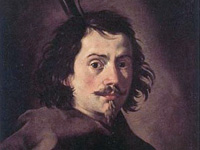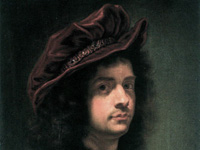BAROQUE ARCHITECTURE
 |
| click to enlarge |
With its 100 domes Rome is the city where the Baroque was born and developed in accordance with rules unique and unrepeatable.
Unrepeatable because the Roman Baroque was inspired by the architecture of the ancient imperial Rome, where on a triumph of marble
and color
stood dominating the grand domes of the Pantheon,
of the imperial Fora and those of the many Thermae.
But if this is the most immediate appearance that unites the two ages, deeper are the reasons that distinguish them.
 |
| click to enlarge |
For its grandeur, for lots of marble, for the richness of colors, the most “baroque” of ancient Roman works is the Forum of Trajan,
whose conception represents plastically the horizon that inspired the Roman world: Roma Caput Mundi.
Therefore, the Forum of Trajan was, nor could it be otherwise, focused on Roma, facts the whole complex is built around the gigantic statue of Trajan,
symbol of the Roman Empire, that stands in the square of the Forum so that the eyes of the 200 Dacian prisoners, from the Basilica Ulpia and arcades are facing the emperor, recognizing the power and majesty of Rome.
This is the world, nothing else exists.
No transcendence.
“Hic et Nunc” (=here and now), would tell the Romans.
A path already started with the first republic and that would lead to a conception of life totally secular.
The world that generates the Baroque is as far as you can imagine from that of the Roman Empire.
The inspiration that generates the Baroque is the Catholic Reform. This Reform matured after terrible events that had shaken the foundations of Catholicism, starting from the Lutheran schism,
followed by the sack of Rome under Pope Clement VII
besieged in Castel Sant'Angelo, then the schism of the Anglican church driven by Henry VIII, and yet the Islamic expansion, while grew severe conflicts between popes and Catholic kings.
This centrifugal tendency was interrupted in 1571 with the victory of the Catholic League in the Battle of Lepanto, following which resumed the unity of the Catholic world around the figure of the Roman Pope.
In this same time imposed a singular figure, Cardinal Felice Peretti, who unlike other prelates came from a humble family. Felice Peretti, in 1585, became Pope Sixtus V, leaving an indelible mark in the history of Rome.
Pope Sixtus reigned only five years from 1585 to 1590, and if as a Cardinal had already exercised great power, during the papacy, with the famous Sixtine plan he revolutionized the urban plan of Rome, so that the lines of the center of the city, are still now the Sixtine ones.
Pope Sixtus wanted Rome, as the center of the Catholic world, to be the most beautiful of cities, thus laying the foundation upon which it developed the Baroque.
Meanwhile, in 1534 was founded the Society of Jesus, that with its missionaries brought the word of Jesus in all continents, sometimes coming into conflict with local churches.
Reflecting on the religious nature that originated the Baroque emerges therefore the difficult coexistence between the missionary church and the triumphant church. The need to overcome this contrast brought the Baroque to develop the concept of transcendence that found application in the creation of forms that move in the space in frantic quest of the divine mystery.
The greatest exponent of this concept was Borromini, who refused the grandeur, indeed contracted the masses, while enhancing the continuity of the movement of forms alternated in tormented opposition, where intense symbolism invoke divine comfort.
The dome of Saint Ivo alla Sapienza worth a thousand words.
On the opposite side moved Bernini,
the greatest exponent of the triumphant church, exalted by the colonnade of St. Peter's Square that welcomes and embraces the faithful.
 |
 |
 |
| Borromini - click to enlarge |
Bernini - click to enlarge |
Baciccia - click to enlarge |
Finally, the concept of the unity of creation, and then of art, found the sublime interpreter in Baciccia,
who in the vault of the church of Jesus (let's go back to the Jesuits) made an unreachable synthesis of architecture, sculpture and painting.
back |

